Tiger King (Advanced Pumpkin Carving)
2028 Views, 6 Favorites, 0 Comments
Tiger King (Advanced Pumpkin Carving)

This is how I carved the Tiger King pumpkin, but you can carve any photo you want on your pumpkin; even yourself! It does take a lot of time and patience, though; about 3 days! (For me anyway.) This takes a long time, so I try to spread it out. Don’t do it too early ahead of time though, this is a real pumpkin and once it’s cut it will begin to rot. When I’m done, I spray the inside and out with a disinfectant spray, to try keep the mold at bay. (I forgot to spray it this year and it was mushy 2 days after Halloween!)
Supplies





Things you will need:
Lots of time and patience.
Tools and Supplies
I’ve collected a lot of different tools over the years, but these are my main tools:
Pointy Xacto blade (for cutting around lines) (or any sharp craft knife.)
Flat square blade (for planing)
Clay loop tools, one large (for thinning the inside, or for scraping off the skin of very large area) and one small (for skinning smaller areas) (I have others in my set, but those 2 are the main ones.) These can be found in the clay area of an art supply store, or ordered online.
A large safety pin or other sharp pointy thing (for poking holes like to make eye highlights or other tiny areas of light)
Photo
Clear packing tape (for waterproofing pattern)
Masking tape (taping pattern to pumpkin)
Large Pumpkin (fairly large and smooth with a flat side will be easier) I use real pumpkins.
Disinfectant wipes (to clean the pumpkin)
Pin cushion with pins (for pin pricking the pattern)
Baby powder (or even flour) to help you see your pattern better.
Thin Serrated pumpkin carving knife (the kind you see in the stores, this is only used to cut out the bottom.)
Large spoon or pumpkin scoop (for gutting the pumpkin)
Pumpkin light (I use a few bright flashlights. Candles won't have enough oxygen inside and are just not bright enough anyway.)
Disinfectant spray (To help keep the mold away.)
Prepare Your Photo





You can google an image, or upload your own photo. Make sure you choose a photo with lots of contrast. Make the photo as large as possible to fit your pumpkin.
I use PhotoShop; but you can find some free imaging software online. Google how to make the photo black and white (gray scale); (it’s called desaturate to make a colored photo black and white.) You can then play with the contrast. Depending on how much work you want to do, you could go with just black and white. Remember, anything black will remain untouched when you begin carving. It is the white that will be cut through and removed.
I like more detail in my pumpkins, so I have shades of gray in mine; those will be cut into different depths of the pumpkin flesh. If you would like to do more detail with different shades, then you will need to posterize it. I like about 5 shades,- black, white, and 3 shades of gray). Google Posterize photo for a free online tool. (In PhotoShop go to: Image-Adjustments-Posterize. Type 5 in the Levels box that pops up, press OK.) This should make your photo with 5 clear levels of gray scale.
Look at your picture; make sure you don’t have any black parts completely encircled by white, as the black piece would just fall out. Edit if you need to.
I like to then tint the whole thing orange. (You don’t have to do this; it makes it easier for me to visualize what my pumpkin will look like...) (To tint in PhotoShop go to: Image-Adjustments-Color Balance-. Move the top slider to Red and the bottom slider to Yellow, press Ok.) Or google tint photo.
Now print out at least 3 copies. (You may have to make it really large and tape it together in pieces.) The one you tape to the pumpkin will end up ruined, so you’ll need another to work from, and a spare just in case. I put clear packing tape on the back of the pattern, since you’ll be pricking the outlines with a pin, this helps prevent the paper from getting too soggy from pumpkin juice.
Slash around the edges of your template. Remember you have to make it fit onto a rounded shape.
Clean and Gut


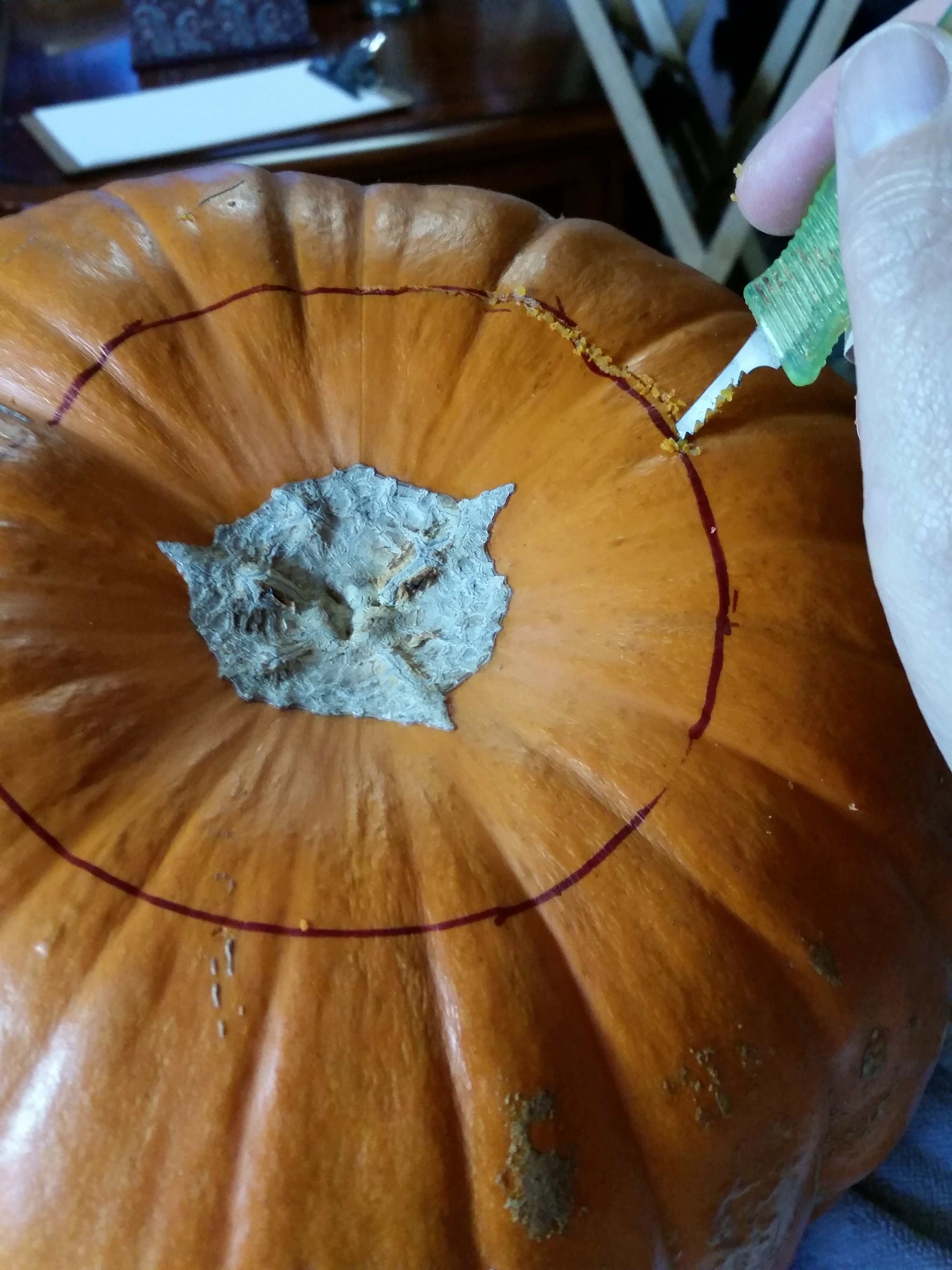
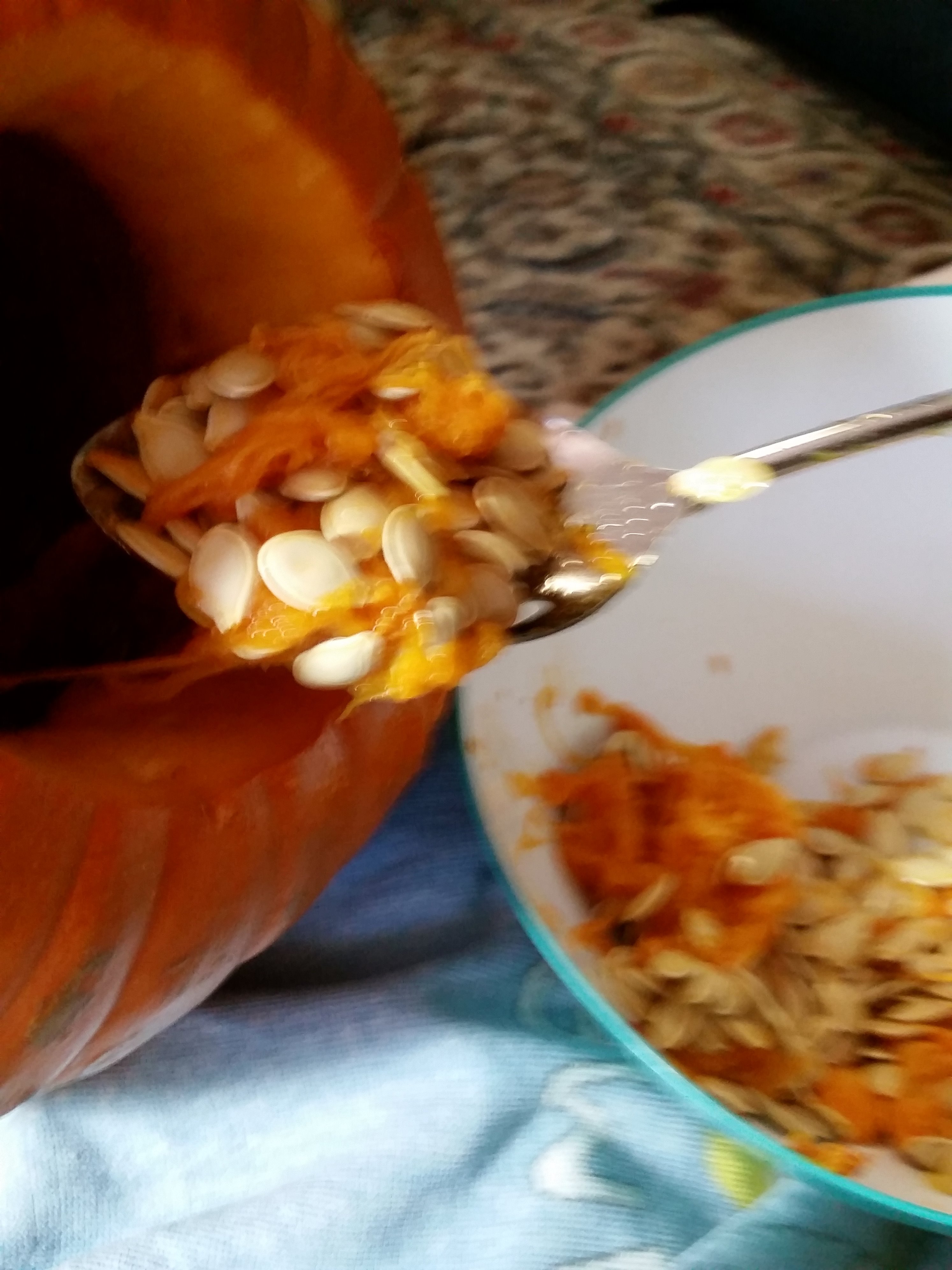
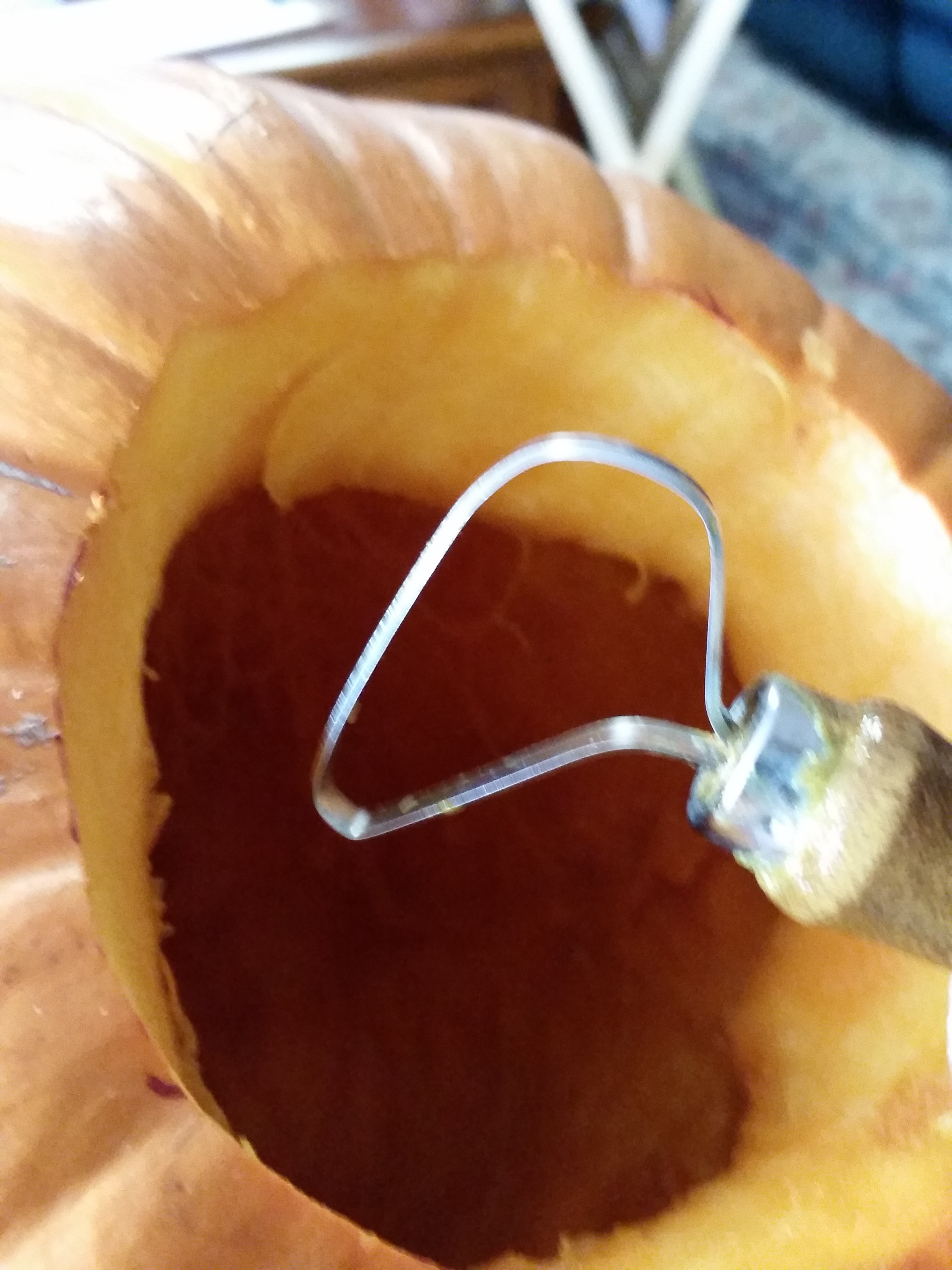
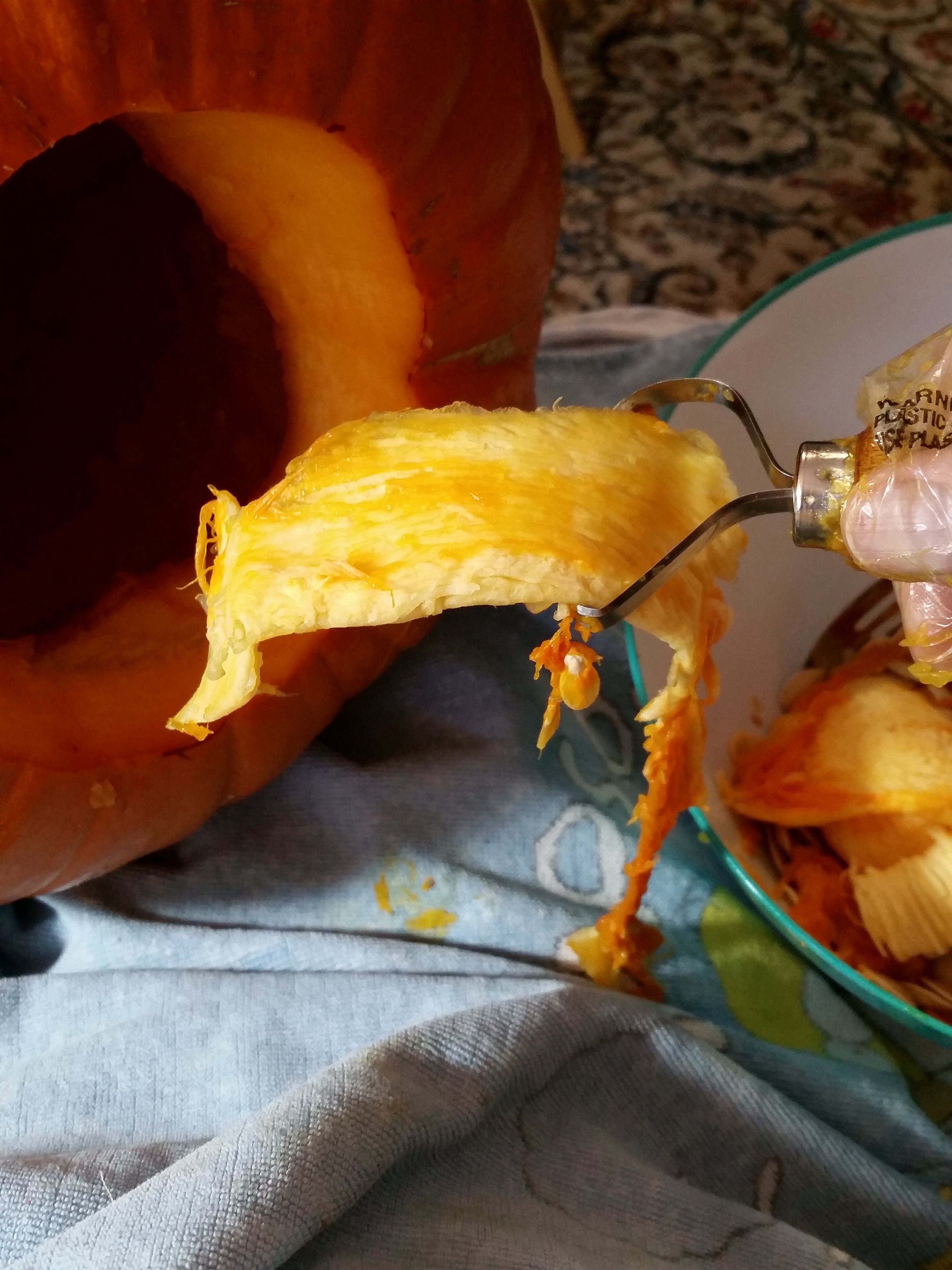
Wash your hands well and clean your pumpkin; I use disinfectant wipes on it. (Bacteria causes it to rot sooner.)
Gut the pumpkin. Sometimes I cut out the top sometimes I cut out the bottom. I just use the standard serrated pumpkin tool; the thinnest one I could find, (a serrated knife will do.) I wear disposable plastic gloves to keep pumpkin guts off me. Use a big spoon or pumpkin scoop and remove seeds and guts.
You’ll need to smooth the inside out. You’ll want the flesh to be no more than an inch thick. (The thinner it is, the more light will show through.) If it is thicker, you’ll have to thin it out from the inside. (You don’t have to thin the entire pumpkin, but just the side that will have the design.) You can use a spoon, but I found a large clay loop tool works really well. Scrape it around the inside and peel off the flesh.
Attatch the Template

Tape your template to your pumpkin on the flattest smoothest side.
I like to pin the picture on through the highlights in the eyes, (the white dots), to prevent it from moving while I’m smoothing it and taping it down.
I lay an old towel on me and cradle the pumpkin in my lap.
You will be pricking the outlines with a pin, (I like to stick pins in it and leave them there; less chance of the template moving.) Yes, it’s tedious but the more pin pricks the better the transfer. Follow all the outlines of the different shades, poking holes through the template and into the pumpkin. (Make sure you get them all, as once you peel off the paper, it’s nearly impossible to match up again.) Some (less important) parts you may want to cut right through the paper into the pumpkin with the Xacto blade.
Peel Off the Paper
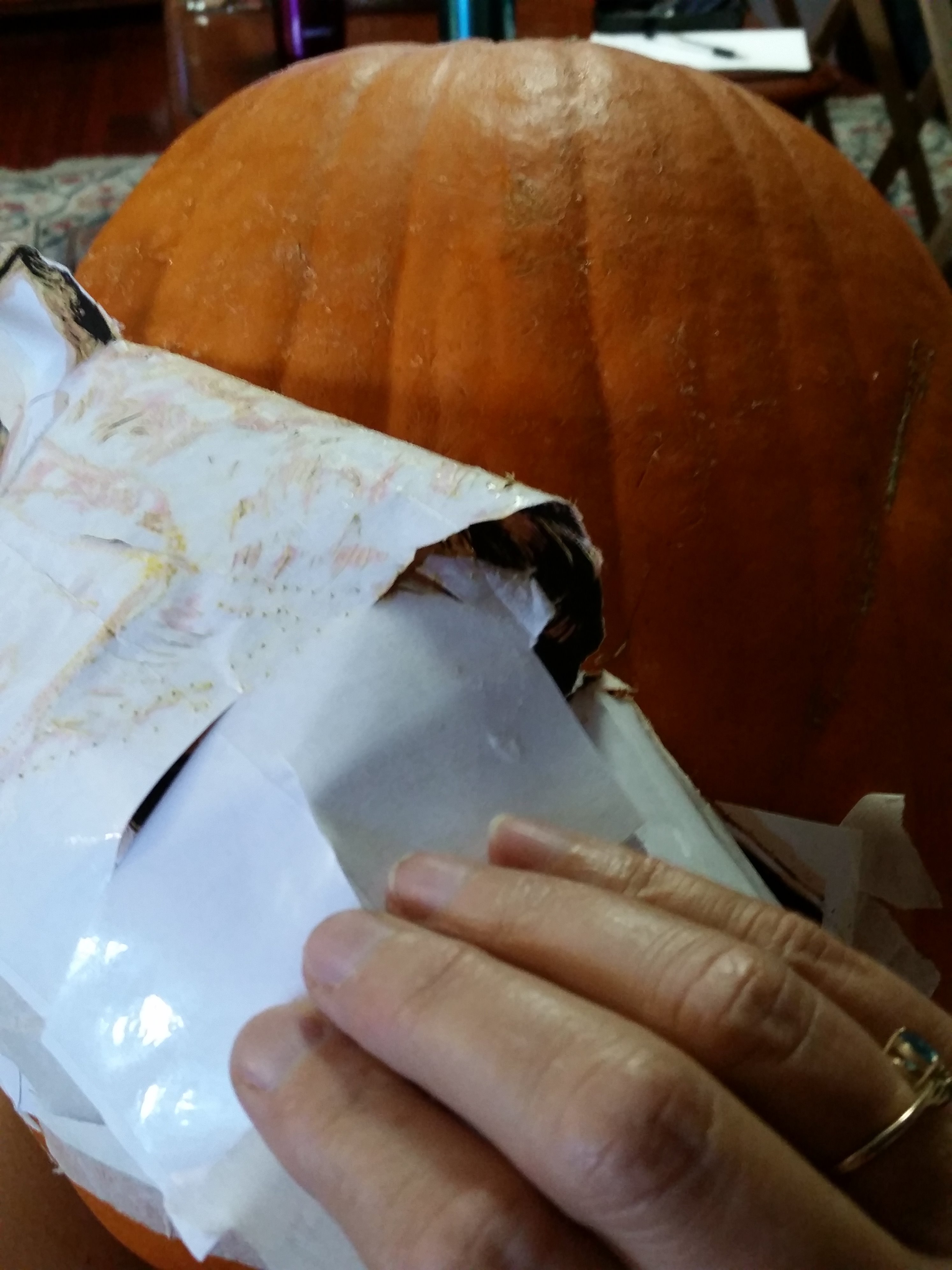




Peel off the paper. Don't worry, you will have transferred the picture with tiny pin holes, even though it doesn’t look like it. Just look closely.) Sometimes bits of paper and dried pumpkin juice are left behind, that’s ok; just wipe it off with a disinfectant wipe or even a wet paper towel.
I found shaking and rubbing a bit of baby powder (or even flour) over the pin prick holes makes them more visible.
Use Xacto Blade
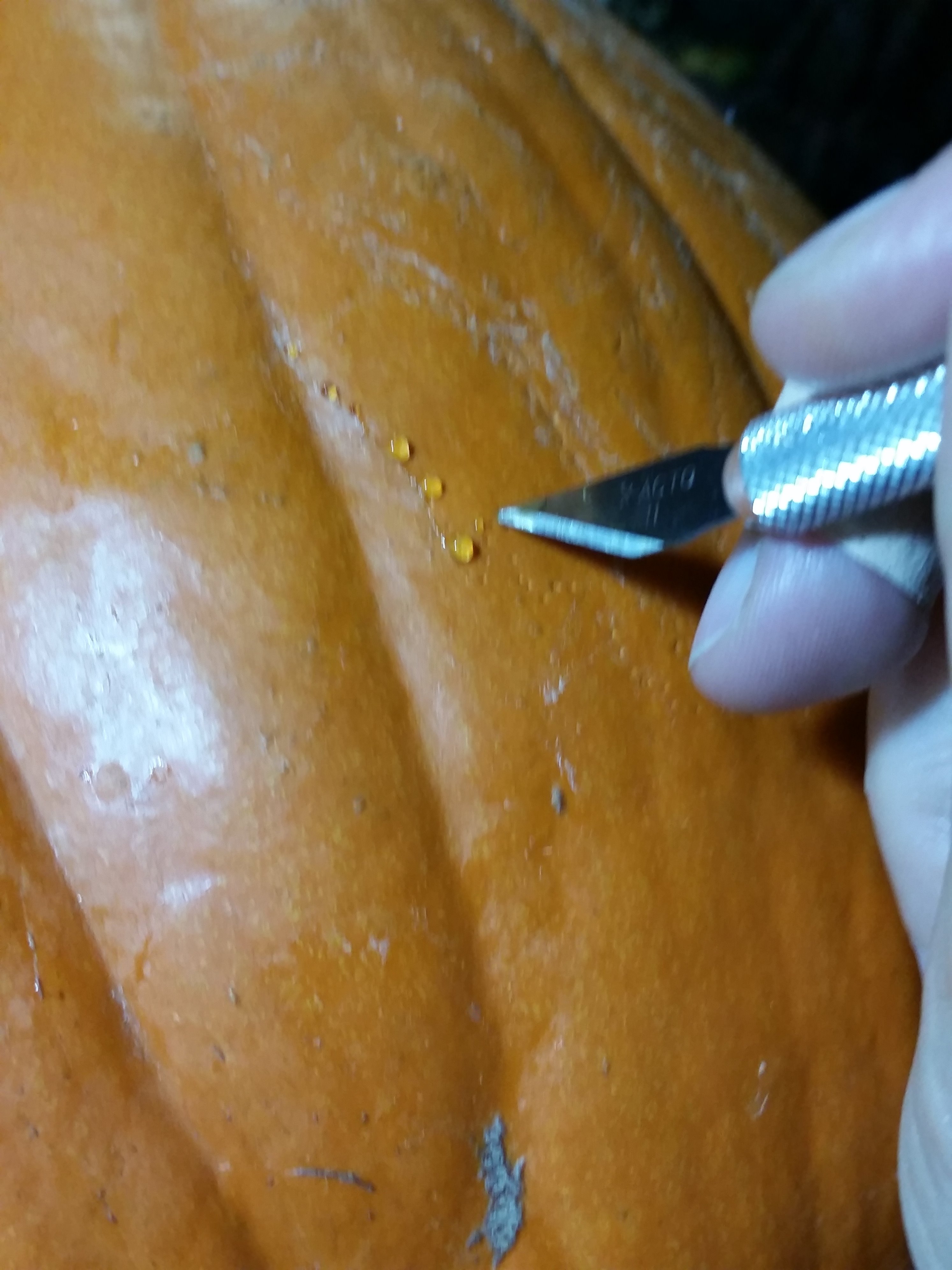
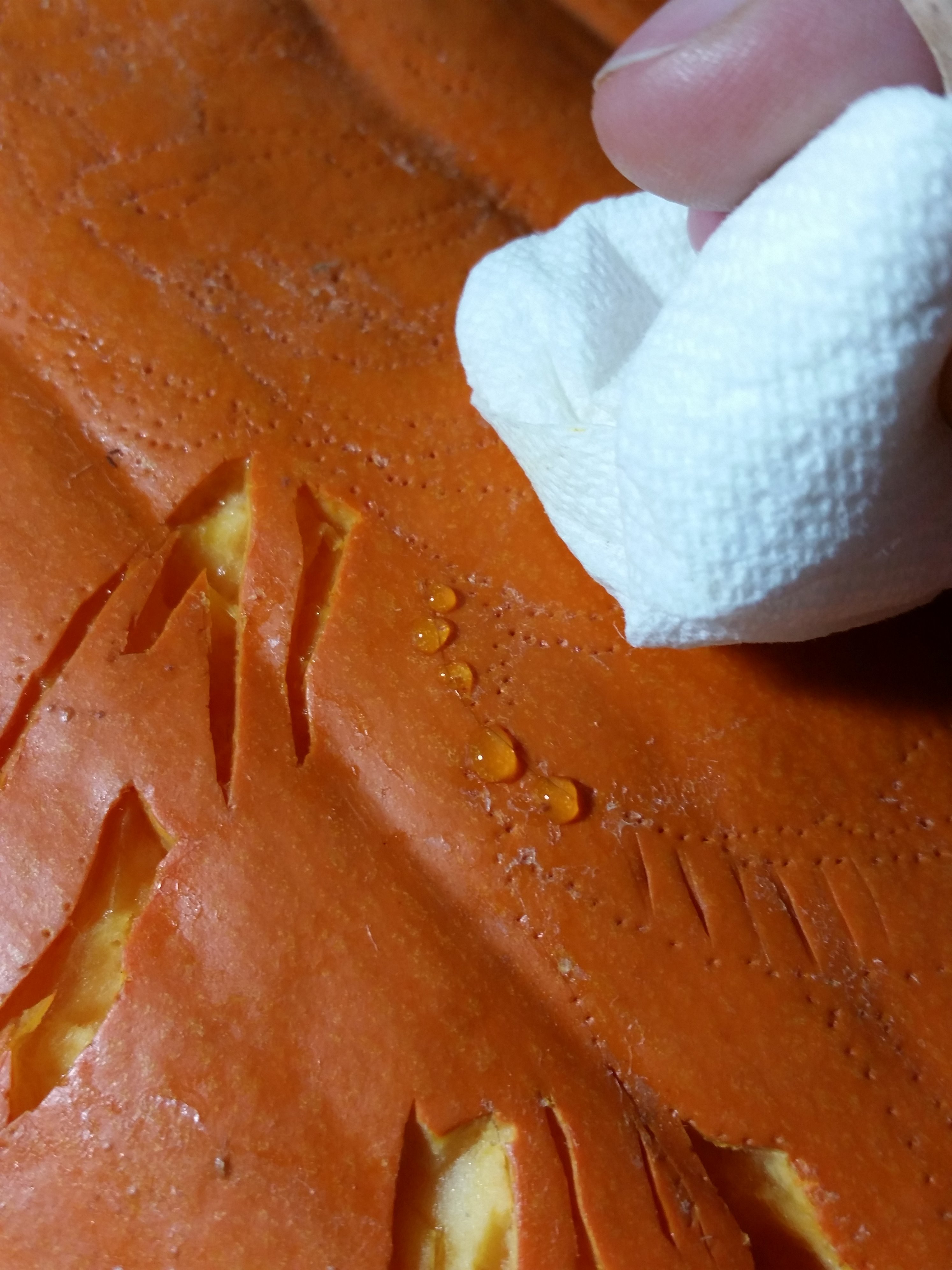
I’m right handed, so it makes sense to start on the upper left so your hand isn’t rubbing all over the cut parts.
Get your non wrecked template and compare it up close to the same parts on the pumpkin, with the pin holes. (Remember, anything that is black will remain untouched orange pumpkin skin, so try not to poke it or scratch it because once you put the light in it will show through.)
Using your Xacto knife, follow the dots with the blade, cutting lines like a “dot to dot” coloring book. (Yes, it will “bleed” pumpkin juice; just dry it off with a paper towel.) Remember you won’t be cutting all the way through on most of these, so don’t go very deep.
Cutting





Now that you have all the outlines cut, it’s time to start cutting at different depths. Usually I start with the parts that are the lightest. I don't usually cut them entirely out and remove them. (I used to, then I realized it looked nicer just very thin instead of cut out.) I trace around the cut part deeper and deeper with the Xacto blade. If the flesh is thicker than the blade, I usually switch to a craft knife that has a breakaway blade and just extend it fully and kind of saw through it carefully. This Tiger King picture did not really have any really white parts.
To do the different shades, you need to first remove the orange skin. First go around the edges again with the pointy blade and cut a little deeper. Then I use the blade that is square and flat (rather than pointy) to kind of plane off the skin. The lighter the shade, the deeper you need to go. Then just plane off the pumpkin meat little by little until you get it smooth, but don’t go all the way through. (You can check to see the shade by turning off the room’s light and sticking the pumpkin light inside.) You can use the clay tools to scrape the flesh away. Towards the end sometime I even work in the dark (with the light inside) shaving bits off to until it looked right.) Do this for all the different shades, there will be different levels for each shade.
Finishing



It seems kind of confusing, because when you are sculpting a face, like say, the nose, would be protruding, but for the nose on a pumpkin to look right when it is lit up, it actually has to be indented. The light shining through the thin wall will highlight it and magically make it look protruded!
Now even when you are done, the outside of the pumpkin in the daylight will not, I repeat, will not, look that great. When you are all done, take it outside and spray the inside and out with disinfectant spray to help keep mold away. (It only helps for a few days though.) Put your pumpkin light in it; I use a few bright flashlights. (Don’t use a candle; there is not enough oxygen inside, and it’s not strong enough anyway).
Once you turn off all the lights and put your pumpkin light inside, it comes to life!